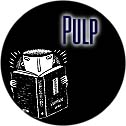
Comment
on this story
|
 |

Oryx and Crake twists modern culture, while Three Junes launches a career
by Julia Watts
Margaret Atwood has been a literary luminary since the 1970s; however, the novel she remains best known for is 1986's The Handmaid's Tale, a dystopian vision of women's lives under the control of a scripture-quoting, misogynist, totalitarian government. The world's current state of affairs has apparently caused more dystopian visions to dance through Atwood's head. Her current novel, Oryx and Crake, looks at the dire consequences of unchecked corporate power, technology at the expense of humanity, and the destruction of the environment.
The protagonist of Oryx and Crake is Snowman (who, in earlier life, was called Jimmy), the last of the dying breed that is humanity. Snowman is regarded as both a prophet and a curiosity by the Crakers, the group of many-colored, vegetarian, nature-loving humanoids among whom he lives. The origin of the Crakers and the way that Snowman becomes their caretaker is one of several mysteries that unfolds over the course of the novel.
Much of Oryx and Crake is told in flashback as Snowman recalls life when there were other people like himself and everyone called him Jimmy. The genius behind the world Atwood creates is how she takes the details of our current lives and twists them just a bit to create the details of her dystopian future.
Jimmy, like all middle-class kids, grows up in a gated suburban compound owned by the corporation for which his father works. Middle-class people are too scared to go into the cities (which they call "pleeblands"), so they hole up in their expertly decorated but sterile compounds and endure routine searches and violations of privacy in the name of "security." Bored by the sterility of their surroundings, teenaged Jimmy and his best friend Crake amuse themselves with ultra-violent computer games and Internet porn.
Jimmy grows up in a world of corporations and cloning. His father works for OrganInc Farms, a corporation which produces pigoons, cloned pigs whose organs can be transplanted to humans without the danger of rejection. Use of the pigoons is considered a breakthrough because it's "...much cheaper than getting yourself cloned for spare parts...or keeping a for-harvest child or two stashed away in some illegal baby orchard." Nature, in the novel, has become something to be manipulated for human gain, and when all this manipulation goes horribly wrong, Snowman is there to witness the horror firsthand.
Also at the heart of Oryx and Crake is a romantic triangle between Snowman, his friend Crake, and a woman they call Oryx, whom they first spotted on an Internet porn site. While this relationship adds some emotional depth to the novel, romantic triangles are nothing new, and the entanglements of these three characters are less interesting than the disturbing world Atwood creates. Oryx and Crake lacks the grand scope of The Handmaid's Tale, but it's still a darkly witty, perceptive, and unsettling look at a future that sometimes feels too much like the present.
Julia Glass may lack Margaret Atwood's status as a long-term literary luminary, but she certainly seems to be heading down the right path after winning the 2002 National Book Award for her first novel, Three Junes. An old-fashioned family saga with a new-fangled structure, Three Junes is written as three novellas set in June of three different years: 1989, 1995, and 1999.
The book shows us three months in the life of a Scottish family: father Paul, mother Maureen, and sons Fenno, David, and Dennis. The first novella, Collies, is a third-person account of the trip newly widowed Paul makes to Greece, where he mourns the memory of his beloved but often emotionally distant wife. Upright, my favorite of the three novellas, is told from the point of view of Fenno, an expatriate bookstore owner in New York City who is struggling to deal with his father's death while caring for his friend Mal, an acerbic music critic who is dying of AIDS. The last of the novellas, Boys, has the difficult job of tying the three novellas into one coherent story. Remarkably, it succeeds.
Like all of the best family sagas, Three Junes is full of death and mourning, birth and joy, and hope found in unexpected places. It is a rare achievement for an author's first novel to be this good.

January 2, 2003 * Vol. 13, No. 1
© 2003 Metro Pulse
|